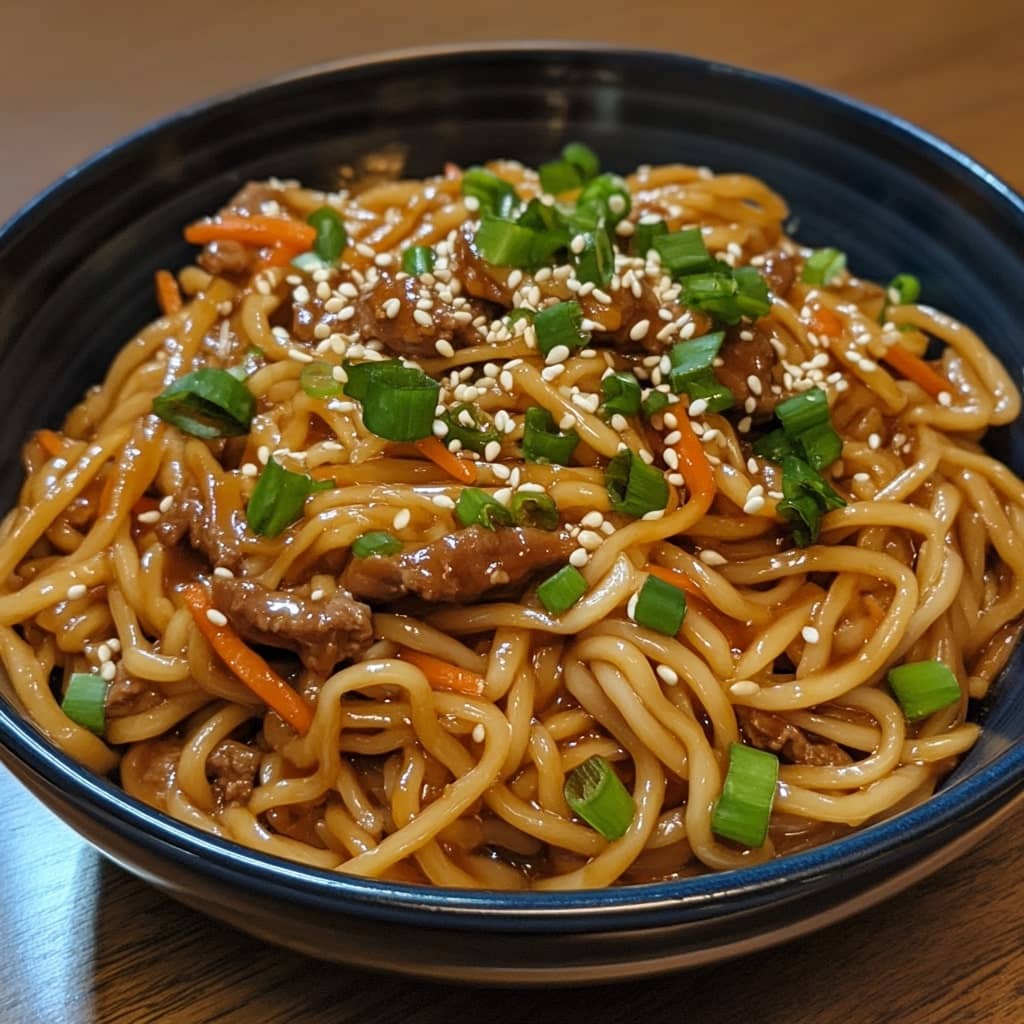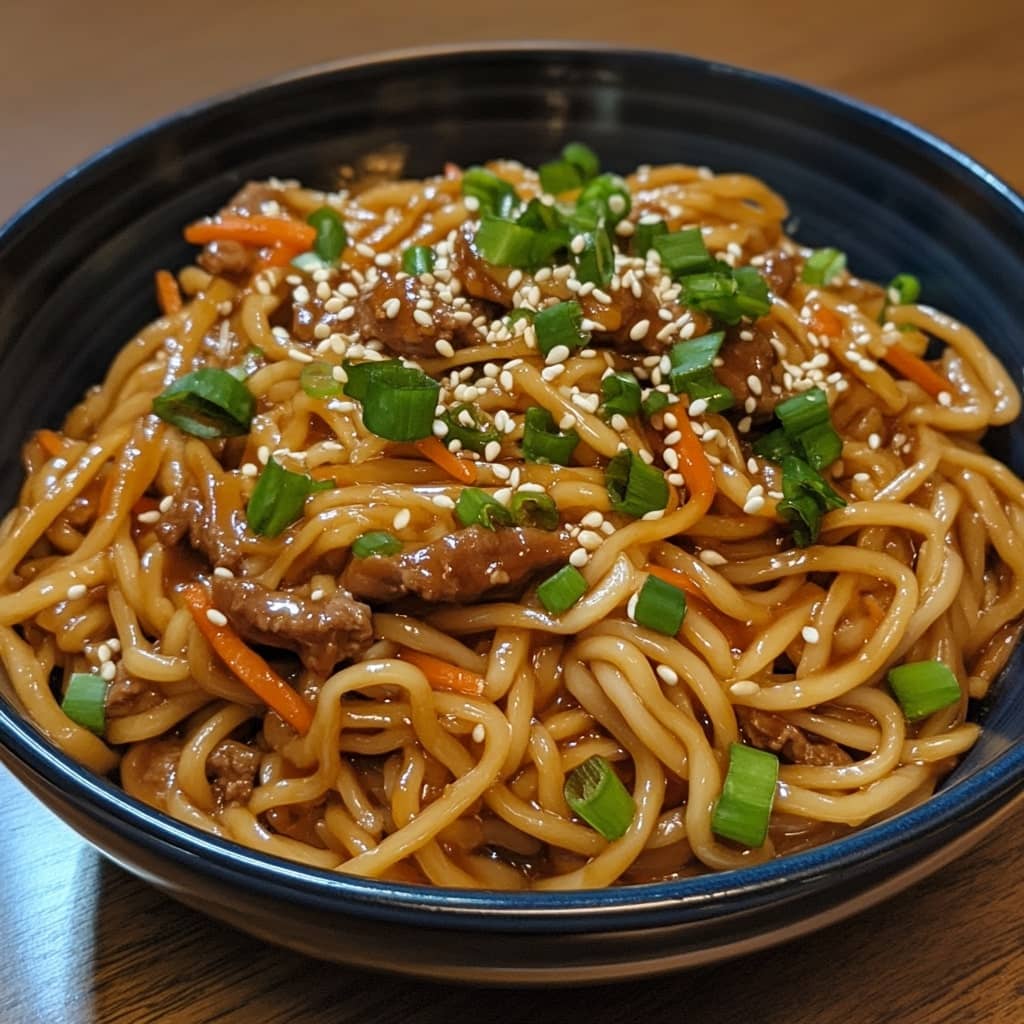Introduction
Soy Sauce Chow Mein is a flavorful and satisfying Chinese dish that has become a favorite in households and restaurants alike. Its origins trace back to traditional Chinese cuisine, where stir-fried noodles are paired with soy sauce, vegetables, and proteins to create a savory, umami-packed meal. This dish is perfect for a quick weeknight dinner or as a side to a larger Asian-inspired meal. The blend of soy sauce, garlic, and vegetables provides a mouthwatering balance of salty and savory flavors, making it a delicious, easy-to-make classic that’s sure to please anyone at the table. Whether you’re a seasoned cook or a beginner, this Soy Sauce Chow Mein recipe offers a versatile and customizable meal that can be prepared in just a matter of minutes.
The History of Soy Sauce Chow Mein
Chow Mein, which translates to “fried noodles” in Chinese, has a long and rich history rooted in Chinese culinary traditions. The dish originated in Northern China but has since evolved into many variations that are enjoyed all around the world. The use of soy sauce as a key ingredient in Chow Mein reflects the deep cultural significance of soy sauce in Chinese cuisine, where it is used for seasoning, marinating, and stir-frying. Traditionally, Chow Mein was made using stir-fried wheat noodles paired with vegetables and a protein such as chicken, beef, or shrimp. Soy sauce Chow Mein, with its simple and savory soy sauce-based seasoning, became popular as it was easily customizable and convenient for busy home cooks. Over time, it gained international recognition, especially in Western countries where Chinese food became a staple in urban communities. The recipe has been embraced and adapted in various regions, offering slight tweaks such as the addition of sesame oil or hoisin sauce, but the foundation of soy sauce remains a key element of the dish.
Ingredients Breakdown
Soy Sauce Chow Mein is made with a handful of simple ingredients that pack a punch of flavor. The star of the dish is the Chow Mein noodles, which are often stir-fried to a golden perfection. The soy sauce provides a rich umami taste, making it the backbone of the sauce. Garlic and ginger are typically used to season the dish, giving it a fragrant, aromatic depth. Vegetables like cabbage, bell peppers, and onions offer a fresh crunch that contrasts nicely with the chewy noodles. The dish can be further enhanced by adding proteins like chicken, beef, shrimp, or tofu, providing an additional layer of flavor and texture. To bring the dish together, sesame oil and a dash of sugar balance out the savory flavors and bring a slight sweetness to the dish. Soy Sauce Chow Mein is easily adaptable to suit various dietary preferences, with plenty of options for both vegetarian and meat-based variations.
Step-by-Step Recipe
- Prepare the Noodles: Begin by cooking the Chow Mein noodles according to the package instructions. Drain the noodles and set them aside.
- Stir-fry the Vegetables: In a large pan or wok, heat a tablespoon of oil over medium-high heat. Add the vegetables such as onions, bell peppers, and cabbage. Stir-fry for 2-3 minutes, until they start to soften but still maintain some crunch. Remove the vegetables from the pan and set them aside.
- Cook the Protein (Optional): If you’re adding a protein like chicken, beef, or shrimp, add it to the pan and stir-fry until fully cooked. Set the protein aside with the vegetables.
- Make the Sauce: In the same pan, add another tablespoon of oil. Stir in the garlic and ginger and sauté for about 1 minute until fragrant. Pour in 3-4 tablespoons of soy sauce, a teaspoon of sugar, and a splash of sesame oil. Stir to combine and bring to a simmer for 2-3 minutes.
- Combine the Noodles and Sauce: Add the cooked noodles back into the pan with the sauce. Toss the noodles in the sauce until they are evenly coated. Add the vegetables and protein back into the pan and stir everything together for another 2-3 minutes to heat through.
- Serve: Garnish with green onions or sesame seeds for added flavor and crunch. Serve immediately and enjoy!
Tips for the Perfect Soy Sauce Chow Mein
- Use Fresh Noodles: If possible, use fresh Chow Mein noodles instead of dried noodles for a more authentic and chewy texture.
- Don’t Overcrowd the Pan: When stir-frying, make sure you don’t overcrowd the pan. This ensures that everything cooks evenly and gets that perfect wok-charred flavor.
- Adjust the Soy Sauce to Taste: Different soy sauces vary in saltiness, so adjust the amount based on your preference. Light soy sauce is milder, while dark soy sauce adds a richer, deeper flavor.
- Add Extra Vegetables: Feel free to add any extra vegetables you like, such as carrots, mushrooms, or baby corn, for added texture and flavor.
- Use a Wok or Large Pan: A wok is ideal for stir-frying, as its shape allows for quick and even cooking, but a large sauté pan will work too.
- For a Spicy Kick: Add some chili flakes or a bit of chili paste to the soy sauce mixture if you like a bit of heat in your Chow Mein.
Variations and Customizations
- Vegetarian Version: Skip the meat and add extra tofu or vegetables like mushrooms, zucchini, or bok choy for a vegetarian-friendly version of the dish.
- Protein Options: Feel free to swap out chicken for shrimp, beef, or pork depending on your preference. Tofu is also a great plant-based protein choice.
- Add Nuts: For a crunchier texture, try adding some cashews or peanuts to the dish. These add flavor and texture that complement the soft noodles.
- Sweet Soy Sauce Chow Mein: For a sweeter variation, add a bit more sugar or a tablespoon of hoisin sauce to the soy sauce mixture for a touch of sweetness.
- Make It Gluten-Free: Use gluten-free soy sauce or tamari sauce and rice noodles for a gluten-free version of this dish.
Health Considerations and Nutritional Value
Soy Sauce Chow Mein can be a healthy meal depending on the ingredients you choose. It’s packed with vegetables, and if you opt for lean proteins like chicken or tofu, it provides a good source of protein. However, it’s important to note that soy sauce is relatively high in sodium, so those watching their salt intake may want to use low-sodium soy sauce. The dish is also relatively high in carbohydrates due to the noodles, but you can reduce the carb count by using zucchini noodles or other vegetable-based alternatives. In terms of fat content, the sesame oil adds a healthy fat, while the butter or oil used for stir-frying may contribute to overall calories. For a lighter version, reduce the oil or creaminess and add more vegetables.
FAQ
- Can I use a different type of noodle?
Yes, you can use rice noodles, egg noodles, or even spaghetti if you prefer. The key is to ensure the noodles are cooked properly before adding them to the sauce. - Is Soy Sauce Chow Mein gluten-free?
Traditional soy sauce is made with wheat, but you can use tamari or gluten-free soy sauce for a gluten-free option. - Can I prepare this dish ahead of time?
Soy Sauce Chow Mein is best served fresh, but you can prep the vegetables and protein in advance. The noodles can also be cooked ahead of time and stored in the refrigerator. Just toss everything together right before serving. - Can I make this dish spicy?
Absolutely! Add some chili paste, red pepper flakes, or even sriracha to the sauce for a spicy kick. - Can I make this dish vegetarian?
Yes, simply omit the meat and add more vegetables or tofu for a hearty vegetarian meal.

SOY SAUCE CHOW MEIN
Ingredients
Method
- Soak fresh or steamed chow mein noodles in boiling water for 20-30 seconds. If using dried chow mein noodles, cook according to the package directions. Rinse in cold water to stop the cooking process and preserve a bouncy texture. Drain well.
- 7 oz fresh thin chow mein
- Chop the scallions into 3-inch pieces, then slice those pieces lengthwise. Keep the white and green parts of the scallions separate. Thinly slice the onion and shallot, if using.
- 4 stalks scallions, 1/4 of an onion, 1 medium shallot
- In a bowl, mix together all the sauce ingredients.
- 1.5 tbsp light soy sauce, 1 tsp dark soy sauce, 1 tbsp oyster sauce, 1 tsp sugar, 1/8 tsp chicken bouillon powder, 1/16 tsp white pepper, 1/2 tsp sesame oil, 2 tbsp water
- Heat a pan over medium-high heat and add 1 tbsp of neutral oil. Add the white parts of the scallions, onions, and shallots. Sauté until lightly caramelized, then push them to one side of the pan.
- Add another tbsp of neutral oil to the pan, then add the drained noodles. Stir-fry for about 1-2 minutes or until dry, then pour the sauce around the perimeter of the pan. Mix well and stir-fry for another 1-2 minutes. If you want crispier, drier noodles, you can stir-fry them a bit longer at this stage.
- Add the bean sprouts and green parts of the scallions. Stir-fry until the bean sprouts have lightly softened but still retain some crunch.
- 2 oz bean sprouts
- Taste and adjust any seasoning. For a darker color, add a bit more dark soy sauce; if you want it saltier, add a bit more light soy sauce. This dish is best enjoyed immediately!
